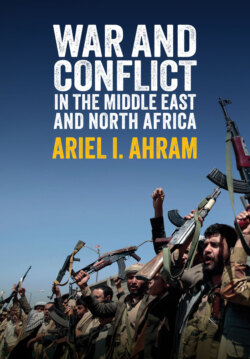Читать книгу War and Conflict in the Middle East and North Africa - Ariel I. Ahram - Страница 10
Why MENA?
ОглавлениеWar occupies a peculiar place in both popular and scholarly discussions of MENA. Certainly, wars are often and repeatedly remarked upon. There are hundreds of texts written about individual wars or enduring conflicts such as the Arab–Israeli wars. There is a burgeoning literature on the more recent civil wars and regional conflicts featuring, among others, the United States, Russia, Iran, Saudi Arabia, the UAE, Turkey, Libya, Yemen, Iraq, Syria, and a host of non-state belligerents.16 Despite this specificity, though, war as a general phenomenon remains an under-explored and under-theorized feature of MENA’s politics. War stands as the elephant in the room in major textbooks on MENA’s international relations. They skirt the burning question of why violent conflict is such a prominent and durable feature in MENA’s regional affairs and how such violence affects the region socially and politically.17
Figure 0.1 MENA’s share of global battle deaths in 2017
Source: Peace Research Institute Oslo/Uppsala Conflict Data Project, data available at https://www.prio.org/Data/Armed-Conflict/UCDP-PRIO/; Nils Petter Gleditsch et al., “Armed Conflict 1946–2001: A New Dataset,” Journal of Peace Research 39, no. 5 (2002): 615–37.
There are a number of reasons why students and scholars should approach the question of conflict and war in MENA. One of the main reasons – and the primary purpose of this book – is analytical. MENA seems to be outside the norm of global peace and stability. We can make this case, albeit anecdotally, by looking at one recent year as an example. According to researchers at the Peace Research Institute Oslo (PRIO) and Uppsala University’s Conflict Data Program (UCDP), premier organizations involved in collecting data on armed conflict, there were forty-nine wars going on around the world in 2017 which claimed a total of about 69,000 lives through battle deaths (battle deaths included both civilians and fighters killed as a result of direct combat). Of these, nine of the wars and 37,500 of the battle deaths occurred in MENA, a region which comprises only one-twentieth of the world’s population, as shown in Figure 0.1. Armed with these figures, it is perhaps natural to presume that MENA suffers a unique pathology, a proclivity to war that spares other, more fortunate, regions.
This book is skeptical about the proposition that there is a unique conflict proneness in MENA, but takes seriously the charge of explaining the factors that seem to make war so frequent in the region. Overall, the book applies the same techniques and approaches to explain conflict in MENA as used in any other part of the world. As discussed later on, a “snapshot” look at cross-national statistics like these can be misleading. Data accuracy is always challenging. Moreover, a focus on battle deaths alone leaves out the impact of war on civilian infrastructure, such as the destruction of hospitals and water treatment facilities, which can lead to further deaths from disease or starvation.18
A second reason to examine war and conflict in MENA is to consider their effects. These statistics on battle deaths and war frequency also do not account for the “long tail” of conflict, its impact on political and economic development. On one hand, MENA’s wars have brought down governments, ruined economies, fractured families, and killed people. On the other hand, wars have also spurred political and economic innovation, catalyzed social transformation, and fostered new senses of national belonging.19 Addressing both the destructive and productive aspects of war in MENA is critical. The sheer variety and profligacy of violence in MENA can yield important insights into the nature of war, conflict, and political order. Twenty years ago, political scientist Steven Heydemann put forth an ambitious agenda to study the interaction between war and social change in the region:
[W]e know relatively little about how states and societies in the Middle East have been shaped and reshaped by their intensive and prolonged exposure to and participation in war making and war preparation, often conducted by regimes that have embraced militarization as an everyday tool of governance as much as (if not more than) a means to ensure national security.20
A number of specialized and country-specific studies have answered this call.21 Still, most generalized accounts of the region neglect war’s role as a catalyst of social change.
A third reason to study conflict and war in MENA is normative. Social science cannot be morally disinterested; it is at its best when it aims to improve the condition of the world.22 The scale of human suffering in MENA demands at least the effort to understand what perpetuates and intensifies these conflicts. Western powers often view MENA as vital to their strategic and economic interests. These powers have had a considerable impact on the war and conflict in MENA, sometimes for peace, sometimes for further war. Citizens of the United States, European countries, or other Western powers have specific responsibilities to examine the policies of their governments.
Still, the book does not offer policy prescriptions or lay blame on any specific actor. It is not inherently pacifist in nature. Yet it attempts to explain outcomes in a way that shows what might – and might not – be possible to avert or mitigate future war.
